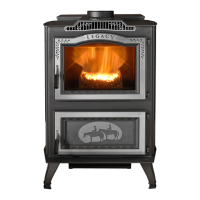13
Do Not Burn Wet Coal!
Super-Magnum Coal Stoker Stove
3-90-02702R8_11/13
Donotburnanyfuelotherthancoal.Neverusehighlyvolatile
substances in your stove, such as gasoline, which could
causeanexplosion.
When solid fuels are burned completely, they produce
waterandcarbondioxide.However,inlongslowburns,a
substantialamountofcarbonmonoxidemaybeproduced.
Ifallowedtobuildup,carbonmonoxide(whichisodorless)
canprovefatallypoisonous.Properventilationanddraftwill
preventthisfromhappening.Ifyousmellsmoke,thoroughly
ventilateyourdwelling,andcontactyourdealerforservice.
Re-testthedraftandproperlysetthebarometricdamper.
Othercausesofpoorventilationordraftareicing,exhaust
fans,ablockedoutsideairinlet,androomairstarvation.If
yourstoveissluggishandyougetoccasionalodor,check
thesepossibilitiesandincreasetheairowinyourhome.
4. Installing to a Prefabricated Chimney
When venting using a prefabricated chimney, be sure
to contact local building code authorities, and to follow
the manufacturer’s instructions exactly. Use only the
manufacturer’s parts; do not use makeshift installation
techniques.All prefabricated chimneys must betested to
eithertheU.S.orCanadianhigh-temperaturestandards,UL
103orULCS629.
1. Existing Masonry Chimneys
Ifyouplanonusingapre-existingmasonrychimney,have
itthoroughlyinspectedandcleaned.Anyfaultswhichmake
thechimneyunsafeandunusablemustberepairedpriorto
use.Thesecanincludeimproperheight,structuraldefects,
blockages,inadequateclearancetocombustibles,unsealed
openingsintootherroomsofthehouse,signsofcreosoteor
smokeleakage,alooseorabsentclean-outdoor,orabsence
of a liner.
2. Venting to a Masonry Chimney
Whenconnectingtoamasonrychimney,severalprovisions
arestandard.First,whetherthechimneyconnectorisvented
tothechimneythroughathimbleorabreechpipe,neither
must pass beyondthe inner surface of the chimney liner,
andbothmustbermlycementedinplacewithrefractory
cement. (A thimble is a masonry pipe which is inserted
through the chimney wall, and is frequently the preferred
method;abreechpipeisapieceofsteelpipeusedthesame
way.)InCanada,abreechpipehasridgesorprotrusionsto
lockitrmlyintotherefractorycement.Ineithercase,the
chimneyconnectorventstothechimneythroughthethimble
orbreechpipe.
Usingathimble,theconnectorslidescompletelyinsidethe
masonrytotheinneredgeoftheueliner,andmaybeeasily
removed for chimney and connector inspection.A breech
pipemustextendatleast2"(50mm)intotheroom,sothe
connectorcanbeattachedwithsheetmetalscrews.
3. Venting to a Masonry Fireplace Chimney
In some situations, a code compliant chimney originally
usedforamasonryreplacemaybeused.Inadditiontothe
requirementsfoundinthepreviousparagraphs,itisimportant
tobeawarethatallclearancesmustbemet,includingthose
fromthechimneyconnectortocombustibles.Donotforgetto
includeoorprotectioninyourplans.(SeeClearancesand
FloorProtectioninthissection.)Sincemanyreplaceshave
exposedwoodenmantelsandtrim,payspecialattentionto
theclearancesnecessarytothesematerials.
Ifyourreplacechimneyisbehindacombustiblewall,you
must use an approved wall pass-through system to gain
access to the masonry chimney. The chimney connector
must enter the chimney at a place where it is lined, and
thereplacemustbe madeinoperable.Forexample,you
mightremovethedamper,replacingitwithasecure,airtight,
noncombustible seal (removable for inspection); this also
satisestherequirementthatnoroomairmustbeallowed
toenterthechimney.
Chimney
Connector
Clay thimble, reaching
just to the inside of the
chimney liner
Mechanical fasteners
(minimum 3) but not at the
bottom of the connector
Chimney liner
inner edges
High-temperature
sealant used to cement
the clay thimble

